Experimental Study on the Performance of a Novel Compact Electrostatic Coalescer with Helical Electrodes
Abstract
1. Introduction
2. Geometry of the Novel Electrostatic Coalescer
3. Experimental Procedure
4. Results and Discussion
4.1. Research on Characteristics of Test Emulsion System
4.2. Effect of the Electric Field Strength
4.3. Effect of the Electric Frequency
4.4. Effect of the Water Content
- (1)
- Water content: 10%
- (2)
- Water content: 20%
- (3)
- Water content: 30%
- (4)
- Water content: 40%
4.5. Effect of the Fluid Velocity
4.6. Comparison of Performance between the Helical Electrode and Parallel-Plate Electrode
5. Conclusions
- (1)
- The application of helical electrodes can help to increase the average residence time of water droplets in the electric field and the emulsion turbulence is also moderately enhanced. It has a better demulsification performance compared with the electrostatic coalescer with parallel-plate electrodes under the same working conditions. This proves that moderate turbulence is beneficial to promote electrostatic coalescence and the helical electrode can improve the performance of electrostatic coalescence and demulsification.
- (2)
- Under the high-frequency/high-voltage AC-pulsed electric field, the water content that the electrostatic coalescer can treat is also high even if the metal helical electrode is used. It has a better demulsification effect and lower equipment energy consumption under a high-frequency/high-voltage AC-pulsed electric field. The high frequency electric field has more obvious advantages than the power frequency (50 Hz) electric field. The combination of an electrostatic coalescer with a helical electrode and high-frequency/high-voltage pulse AC power supply technology is feasible
- (3)
- Increasing the residence time of water droplets in the electric field and forming moderate turbulence can both promote electrostatic coalescence. The influence of fluid velocity and the residence time in the electric field should be comprehensively considered when designing an electrostatic coalescer. It is particularly important to determine the appropriate fluid velocity.
Author Contributions
Funding
Institutional Review Board Statement
Informed Consent Statement
Data Availability Statement
Conflicts of Interest
References
- Hamoud, A.A.; Al Ghamdi, S.M. Applications of Multiphase Technologies Optimize Upstream Operations in Saudi Aramco. In Proceedings of the SPE Asia Pacific Oil and Gas Conference, Perth, Australia, 20–22 October 2008. [Google Scholar]
- Sun, D.Z.; Jong, S.C.; Duan, X.D.; Zhou, D. Demulsification of water-in-oil emulsion by wetting coalescence materials in stirred- and packed-columns. Colloids Surf. A 1999, 150, 69–75. [Google Scholar]
- Menon, V.B. Encyclopedia of Emulsion Technology; Marcel Dekker Inc.: New York, NY, USA, 1985; Volume 2. [Google Scholar]
- Wu, J.; Xu, Y.; Dabros, T.; Hamza, H. Effect of demulsifier properties on destabilization of water-in-oil emulsion. Energy Fuels 2003, 17, 1554–1559. [Google Scholar] [CrossRef]
- Mohammed, R.A.; Bailey, A.I.; Luckham, P.F.; Taylor, S.E. Dewatering of crude oil emulsions. 3. Emulsion resolution by chemical means. Colloids Surf. A 1994, 83, 261–271. [Google Scholar] [CrossRef]
- Wang, D.; Yang, D.L.; Huang, C.; Yang, D.Z. Stabilization mechanism and chemical demulsification of water-in-oil and oil-in-water emulsions in petroleum industry: A review. Fuel 2021, 286, 119390. [Google Scholar] [CrossRef]
- Lissant, K.J. Demulsification: Industrial Application; Surfactant Science Series 13; Marcel Dekkar: New York, NY, USA, 1983. [Google Scholar]
- Mori, Y.; Tanigaki, M.; Maehara, N.; Eguchi, W. Effect of Frequency in a.c. high voltage on coalescence of water-in-oil emulsion stabilized with sorbitan monooleate type nonionic surfactant. J. Chem. Eng. Jpn. 1994, 27, 340–343. [Google Scholar] [CrossRef]
- Simone, L.; Hannisdal, A.; Sjöblom, J. An electrorheological study on the behavior of water-in-crude oil emulsions under influence of a DC electric field and different flow conditions. J. Dispers. Sci. Technol. 2008, 29, 106–114. [Google Scholar]
- Simone, L.; Hannisdal, A.; Bjørklund, E.; Sjöblom, J. Electrostatic destabilization of water-in-crude oil emulsions: Application to a real case and evaluation of the Aibel VIEC technology. Fuel 2008, 87, 2572–2581. [Google Scholar]
- Eow, J.S.; Mojtaba, G.; Sharif, A.O. Electrostatic enhancement of coalescence of water droplets in oil: A review of the current understanding. Chem. Eng. J. 2001, 84, 173–192. [Google Scholar] [CrossRef]
- Ferreira, B.M.S.; Ramalho, J.B.V.S.; Lucas, E.F. Demulsification of water-in-crude oil emulsions by microwave radiation: Effect of aging, demulsifier addition, and selective heating. Energy Fuels 2013, 27, 615–621. [Google Scholar] [CrossRef]
- Luo, X.M.; Gong, H.Y.; Cao, J.H.; Yin, H.R. Enhanced separation of water-in-oil emulsions using ultrasonic standing waves. Chem. Eng. Sci. 2019, 203, 285–292. [Google Scholar] [CrossRef]
- Reza, Z.; Ahmadun, F.; Luqman, C.; Abdullah, S.; Elnashaie, A.P. Demulsification techniques of water-in-oil and oil-in-water emulsions in petroleum industry. Sep. Purif. Technol. 2016, 170, 377–407. [Google Scholar]
- Urdahl, O.; Williams, T.J.; Bailey, A.G. Electrostatic destabilization of water-in-oil emulsions under conditions of turbulent-flow. Chem. Eng. Res. Des. 1996, 74, 158–165. [Google Scholar]
- Harpur, I.G.; Wayth, N.J.; Bailey, A.G. Destabilisation of water-in-oil emulsions under the influence of an AC electric field: Experimental assessment of performance. J. Electrost. 1997, 40, 135–140. [Google Scholar] [CrossRef]
- Gary, W.S.; Floyd, L.P.; Merle, B.I. Apparatus for Augmenting the Coalescence of Water in a Water-in-Oil Emulsion. US Patent 5,565,078, 15 October 1996. [Google Scholar]
- Isabelle, P.; Alexandre, R. Process for Separating Phases of Different Densities and Conductivities by Electrocoalescence and Centrifugation. US Patent 5,643,469, 1 July 1997. [Google Scholar]
- Berry, J.P.; Stewart, J.M.; Adrian, G.B. Compact Electrostatic Coalescer. US Patent 6,136,174 A1, 24 October 2000. [Google Scholar]
- Urdahl, O.; Nordstad, K.; Berry, P. Development of a New Compact Electrostatic Coalescer Concept. In Proceedings of the SPE Annual Technical Conference and Exhibition, New Orleans, LA, USA, 30 September–3 October 2001. [Google Scholar]
- Westra, R.; Akdim, M.R. Compact oil-water separation using the inline electrocoalescer and the cyclonic dewaterer. In Proceedings of the International Petroleum Technology Conference, Bangkok, Thailand, 15–17 November 2011. [Google Scholar]
- Grave, E.J.; Olson, M.D.; Menchaca, A.E. Performance testing of an inline electrocoalescer device with medium and heavy crudes. Oil Gas Facil. 2015, 4, 56–65. [Google Scholar] [CrossRef]
- Taylor, S.E. Theory and practice of electrically enhanced phase separation of water-in-oil emulsions. Chem. Eng. Res. Des. 1996, 74, 526–540. [Google Scholar]
- Christine, N.; Chen, J.Q.; Christine, D. Electrostatic Demulsification on Crude Oil: A State-of-the-Art Review. In Proceedings of the SPE International Oil & Gas Conference and Exhibition, Beijing, China, 5–7 December 2006. [Google Scholar]
- Atten, P. Electrocoalescence of water droplets in an insulating liquid. J. Electrost. 1993, 30, 259–269. [Google Scholar] [CrossRef]
- Urdahl, O.; Wayth, N.J.; Fordedal, H. Encyclopedic Handbook of Emulsion Technology; Sjöblom, J., Ed.; CRC Press: Boca Raton, FL, USA, 2001; pp. 679–693. [Google Scholar]
- Melheim, J.A.; Matteo, C. Simulation of turbulent electrocoalescence. Chem. Eng. Sci. 2006, 61, 4540–4549. [Google Scholar] [CrossRef]
- Li, Q.; Chen, J.Q.; Liang, M. Investigation of water separation from water-in-oil emulsion using high-frequency pulsed AC electric field by new equipment. J. Dispers. Sci. Technol. 2015, 36, 918–923. [Google Scholar] [CrossRef]
- Nath, B.; Borthakur, M.P.; Biswas, G. Electric field induced dynamics of viscoplastic droplets in shear flow. Phys. Fluids 2020, 32, 092110. [Google Scholar] [CrossRef]
- Ismail, A.S.M.; Menchaca, A.E.; Balk, W.; Akdim, M.R.; Less, S.; Oshinowo, L. High-performance electrostatic coalescer-a novel technology for improving the economics of oil-water separation. In Proceedings of the Abu Dhabi International Petroleum Exhibition and Conference, Abu Dhabi, United Arab Emirates, 9–12 November 2020. [Google Scholar]
- Sameer, M.; Rochish, T. Electrocoalescence in non-uniform electric fields: An experimental study. Chem. Eng. Process. 2015, 96, 28–38. [Google Scholar]
- Luo, S.R.; Jarrod, S.; Luo, T.F. Effect of electric field non-uniformity on droplets coalescence. Phys. Chem. Chem. Phys. 2016, 18, 29786–29796. [Google Scholar] [CrossRef] [PubMed]
- Li, B.; Vivacqua, V.; Wang, J.F. Electrocoalescence of water droplets in sunflower oil using a novel electrode geometry. Chem. Eng. Res. Des. 2019, 152, 226–241. [Google Scholar] [CrossRef]
- Zhou, Y.T.; Li, B.; Zhang, M.Y.; Sun, Z.Q.; Wang, Z.B.; Wang, J.J. Effect of dielectrophoresis on the coalescence of binary droplets under a non-uniform electric field. Chem. Eng. Sci. 2020, 224, 115739. [Google Scholar] [CrossRef]
- Gong, H.F.; Li, W.L.; Zhang, X.M.; Peng, Y.; Yu, B.; Mou, Y. Effects of droplet dynamic characteristics on the separation performance of a demulsification and dewatering device coupling electric and centrifugal fields. Sep. Purif. Technol. 2021, 257, 117905. [Google Scholar] [CrossRef]

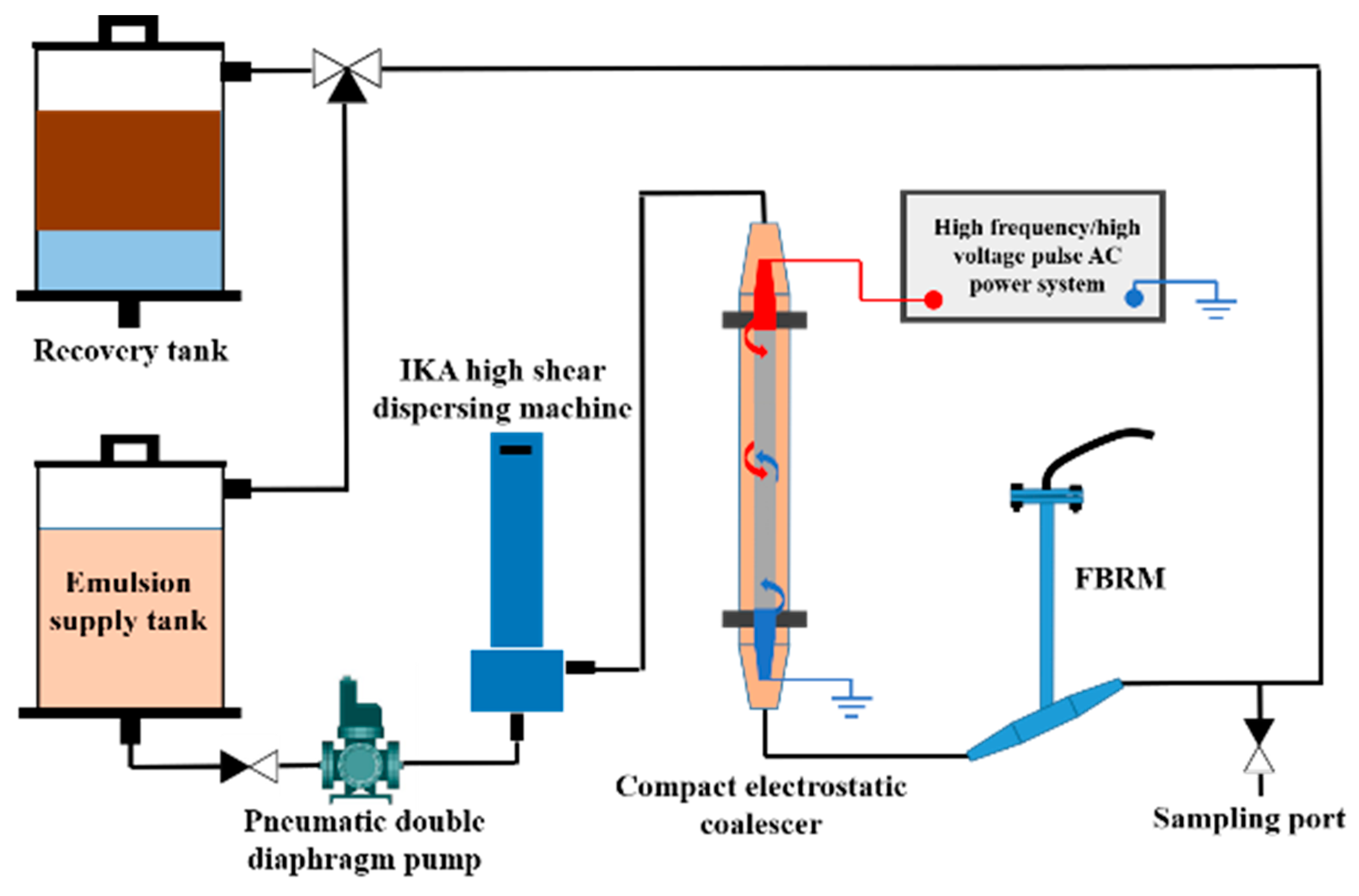

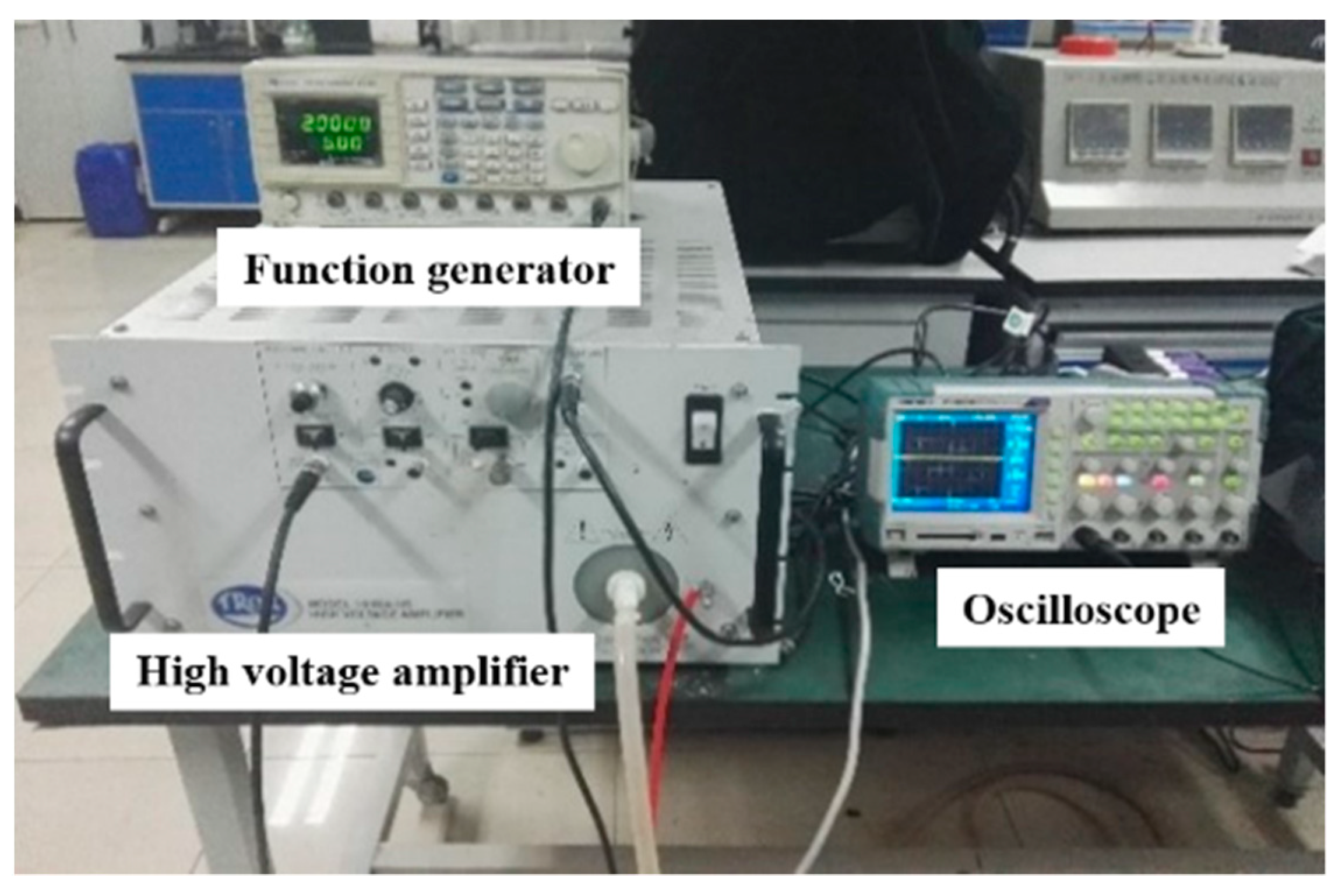

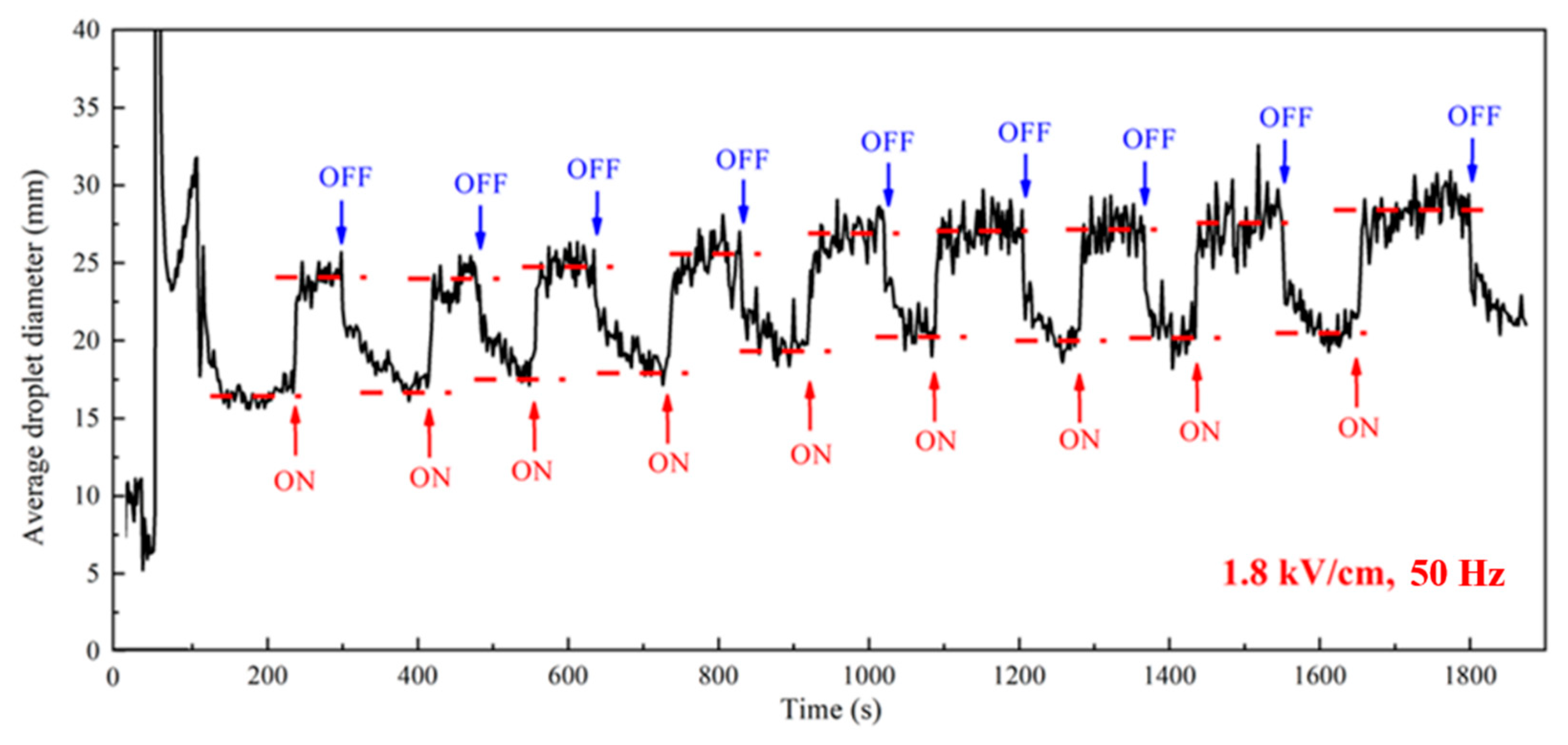


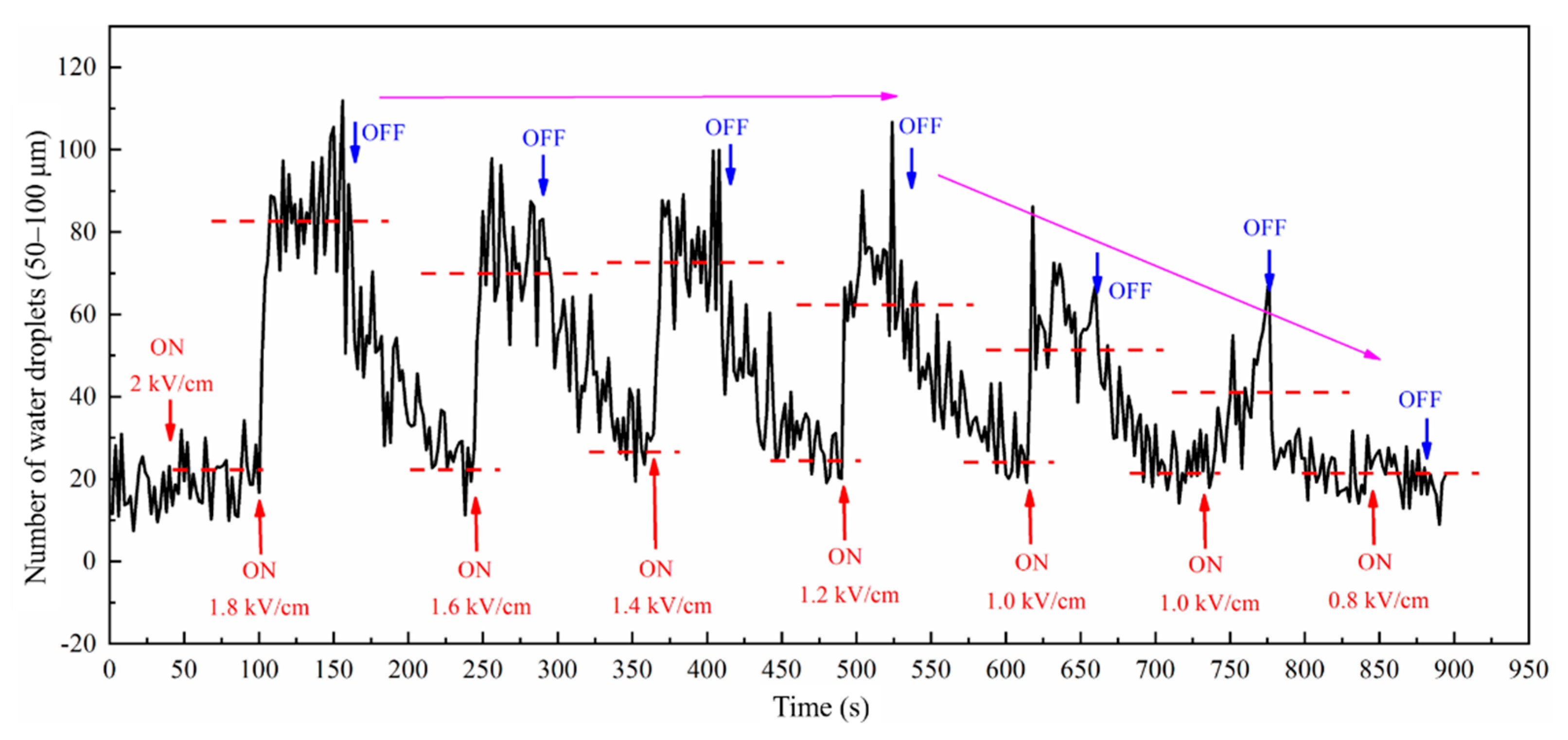

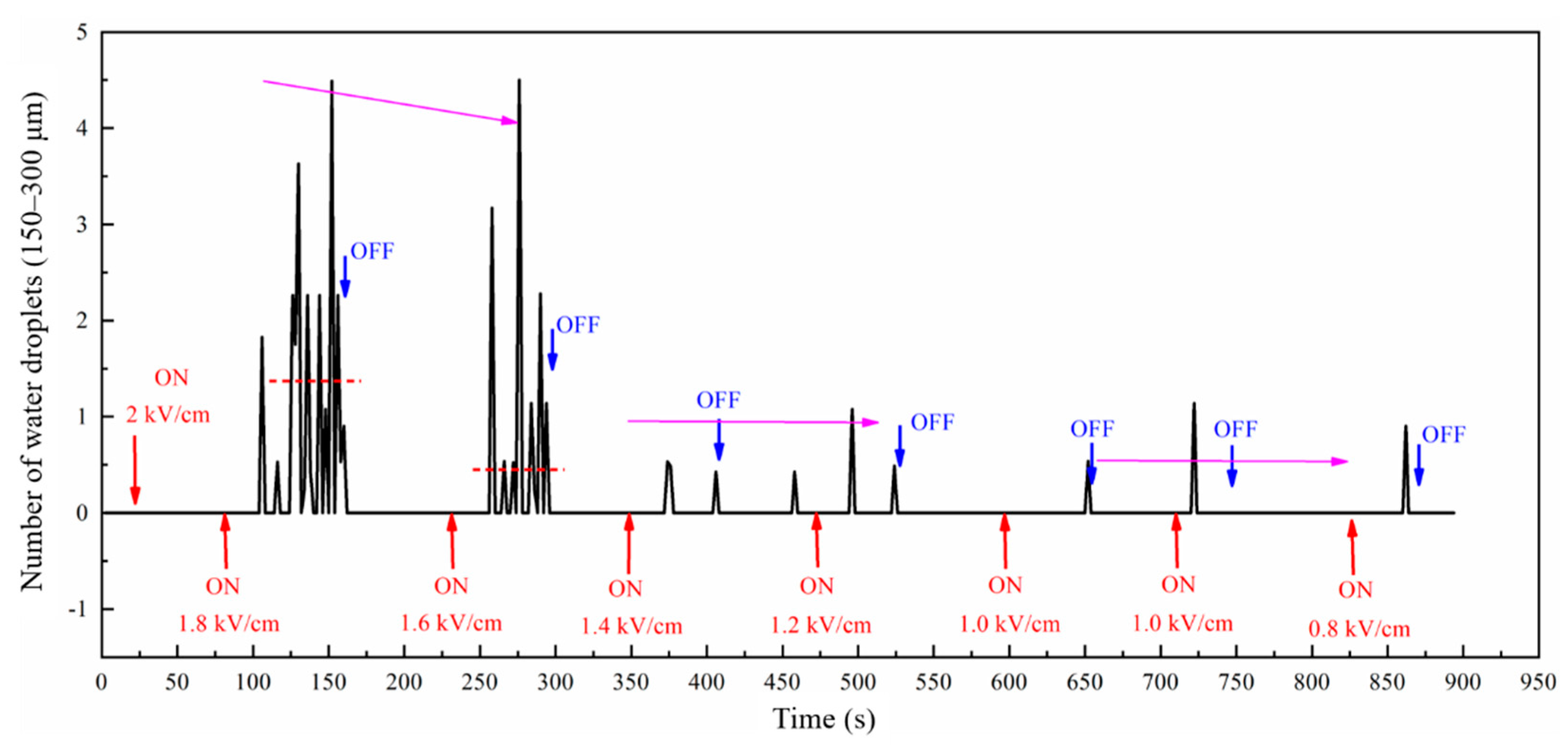



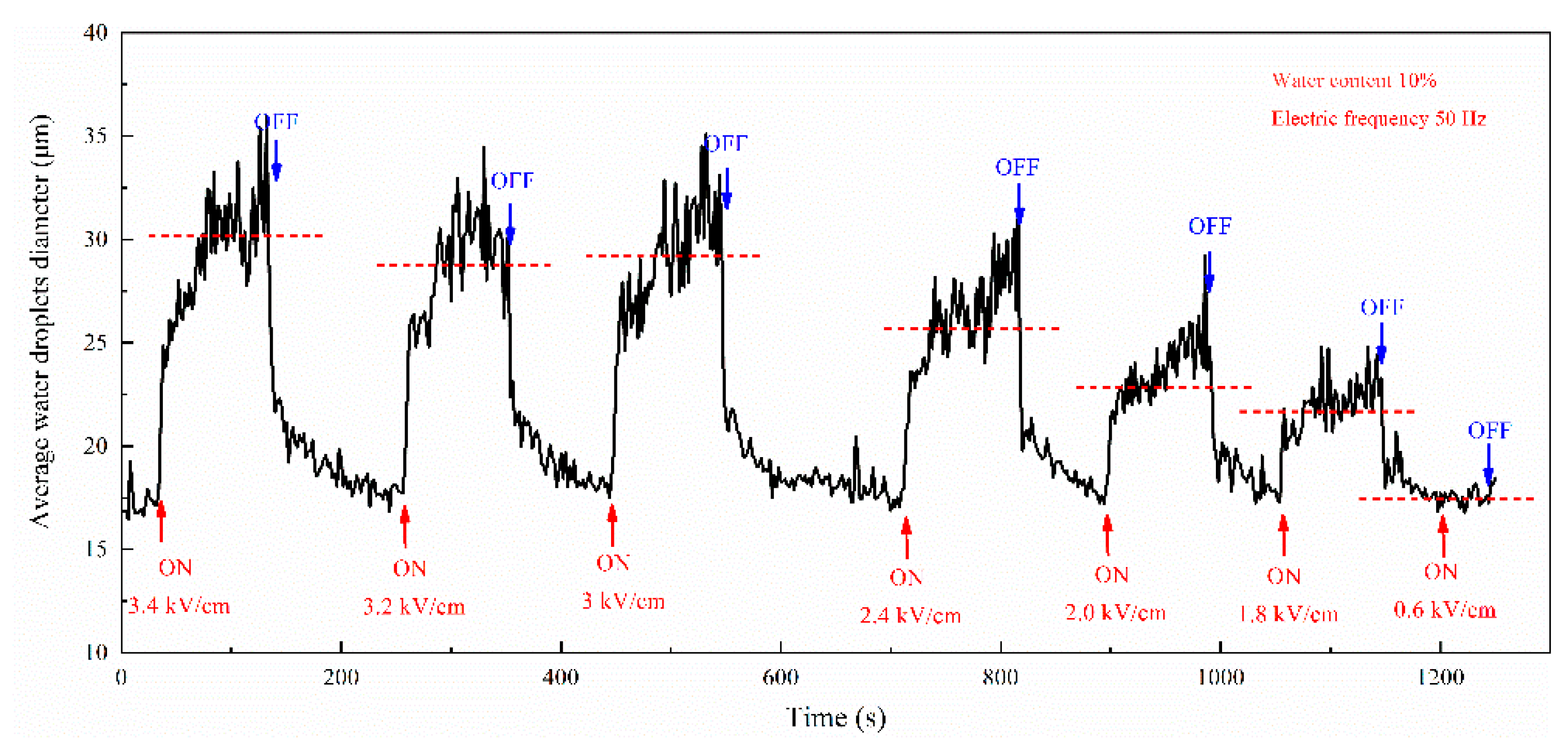





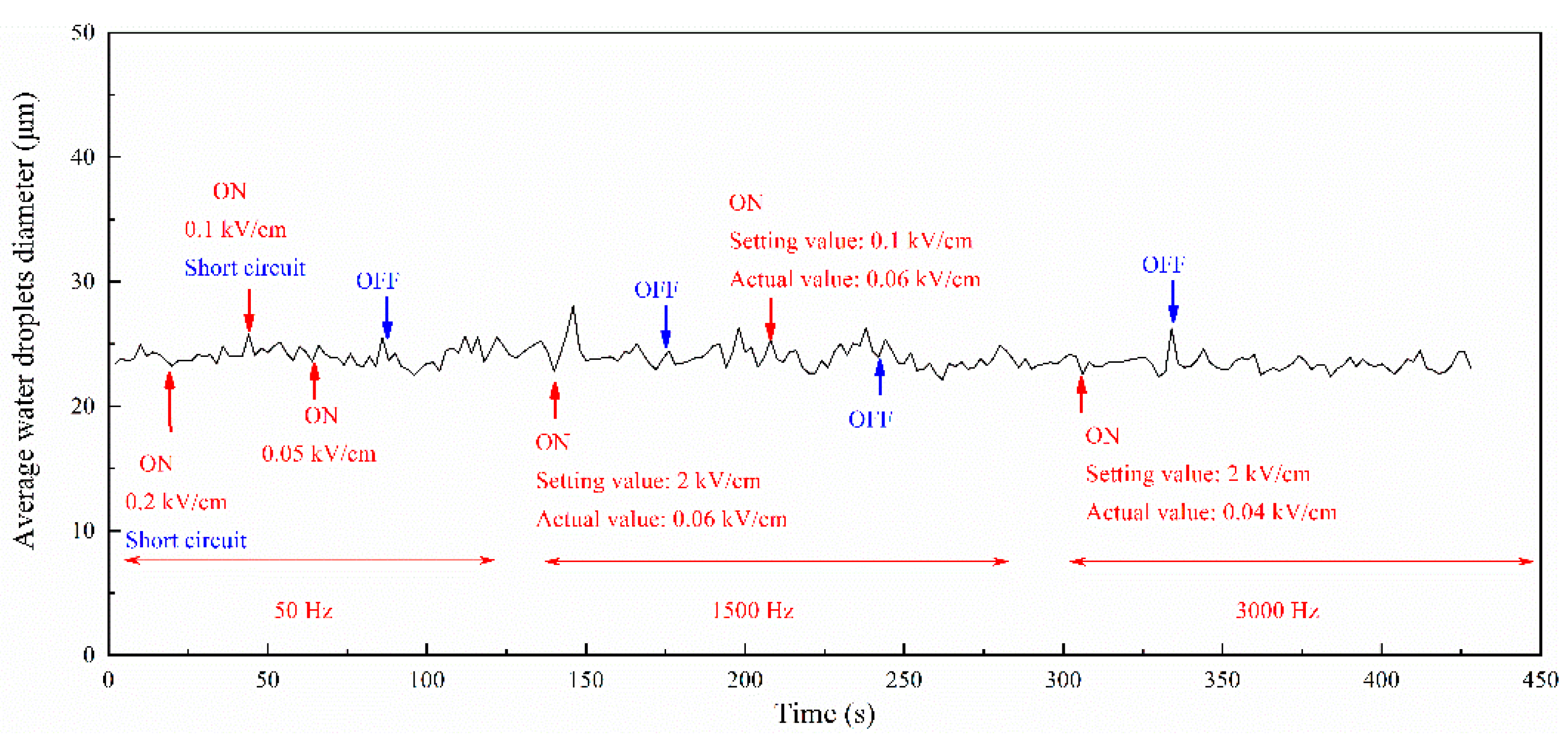
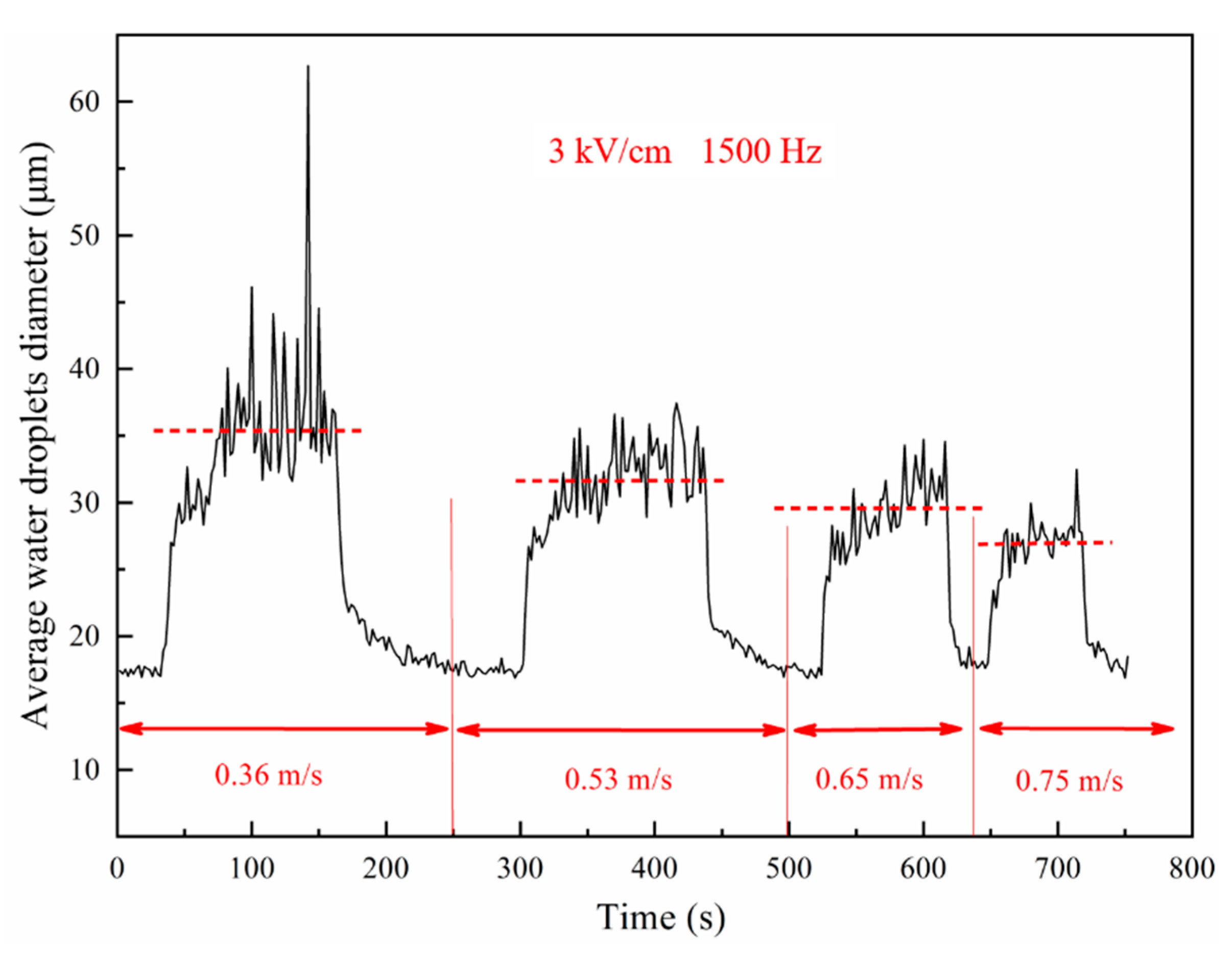

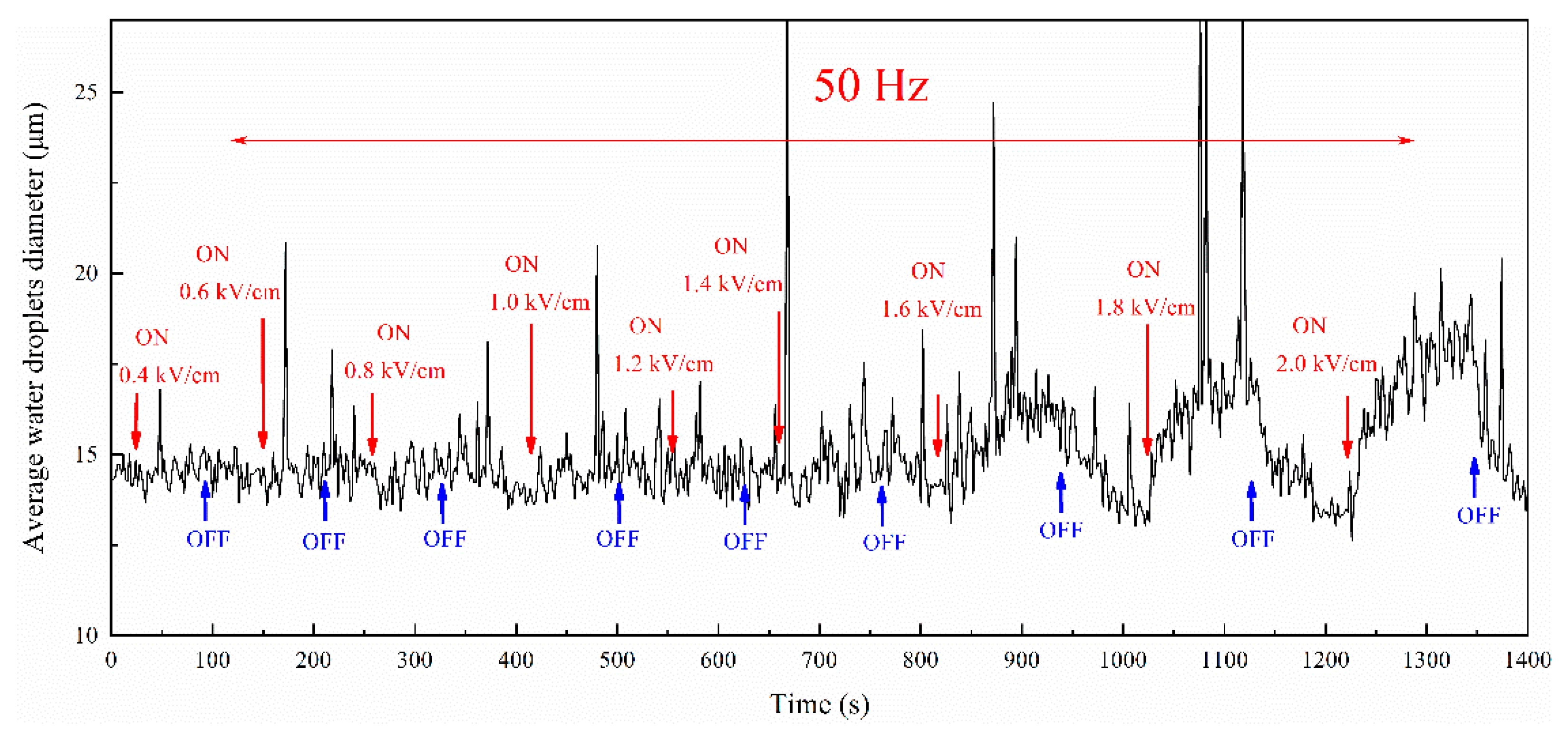
| Parameters | Value |
|---|---|
| Design volume flowrate (m3/h) | 2 |
| Inlet diameter (mm) | 12.7 |
| Outlet diameter (mm) | 12.7 |
| Outlet diameter of helical blade (mm) | 30 |
| Inner diameter of helical blade (mm) | 18 |
| Thickness of helical blade (mm) | 3 |
| Length of the helical channel (mm) | 500 |
| Flow Condition Parameters | Electrical Field Parameters | ||||
|---|---|---|---|---|---|
| Velocity (m/s) | Water Content (%) | Amount of Emulsifier (g/L) | Rotational Speed of Shear Dispersing Machine (r/min) | Electric Frequency (Hz) | Electric Field Strength (kV/cm) |
| 0.44 | 15 | 7 | 8000 | 50 | 0.4 |
| 0.6 | |||||
| 0.8 | |||||
| 1 | |||||
| 1.2 | |||||
| 1.4 | |||||
| 1.6 | |||||
| 1.8 | |||||
| 2 | |||||
| Flow Condition Parameters | Electrical Field Parameters | ||||
|---|---|---|---|---|---|
| Velocity (m/s) | Water Content (%) | Amount of Emulsifier (g/L) | Rotational Speed of Shear Dispersing Machine (r/min) | Electric Field Strength (kV/cm) | Electric Frequency (Hz) |
| 0.44 | 15 | 7 | 8000 | 1.8 | 50 |
| 500 | |||||
| 1000 | |||||
| 1500 | |||||
| 2000 | |||||
| 2500 | |||||
| 3000 | |||||
| 2.2 | 3000 | ||||
| 2.4 | |||||
| 2.6 | |||||
| 2.8 | |||||
| 3.0 | |||||
| 3.1 | |||||
| 3.2 | |||||
| 4.0 | |||||
| 4.8 | |||||
| Flow Conditions | Electric Field Parameters | ||||
|---|---|---|---|---|---|
| Water Content (%) | Amount of Emulsifier (g/L) | Rotational Speed of Shear Dispersing Machine (r/min) | Velocity (m/s) | Electric Frequency (Hz) | Electric Field Strength (kV/cm) |
| 15 | 7 | 8000 | 0.36 | 1500 | 3 |
| 0.53 | |||||
| 0.65 | |||||
| 0.75 | |||||
Publisher’s Note: MDPI stays neutral with regard to jurisdictional claims in published maps and institutional affiliations. |
© 2021 by the authors. Licensee MDPI, Basel, Switzerland. This article is an open access article distributed under the terms and conditions of the Creative Commons Attribution (CC BY) license (http://creativecommons.org/licenses/by/4.0/).
Share and Cite
Shi, Y.; Chen, J.; Pan, Z. Experimental Study on the Performance of a Novel Compact Electrostatic Coalescer with Helical Electrodes. Energies 2021, 14, 1733. https://doi.org/10.3390/en14061733
Shi Y, Chen J, Pan Z. Experimental Study on the Performance of a Novel Compact Electrostatic Coalescer with Helical Electrodes. Energies. 2021; 14(6):1733. https://doi.org/10.3390/en14061733
Chicago/Turabian StyleShi, Yi, Jiaqing Chen, and Zehao Pan. 2021. "Experimental Study on the Performance of a Novel Compact Electrostatic Coalescer with Helical Electrodes" Energies 14, no. 6: 1733. https://doi.org/10.3390/en14061733
APA StyleShi, Y., Chen, J., & Pan, Z. (2021). Experimental Study on the Performance of a Novel Compact Electrostatic Coalescer with Helical Electrodes. Energies, 14(6), 1733. https://doi.org/10.3390/en14061733





